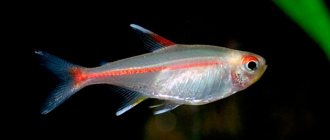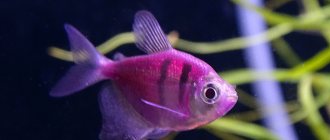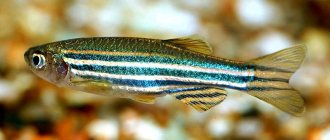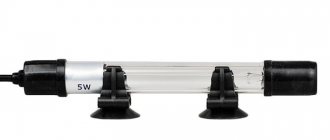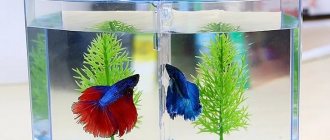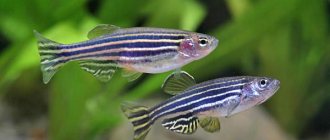Origin
The main foundation for colored zebrafish was the 3-centimeter Indian lake fish, known to almost everyone - zebrafish. Their distinctive feature is the colored stripes of blue and gold along the body (because of this, they are sometimes identified as zebra danios).
Specialists from National Taiwan University have successfully completed work on breeding a new fish with a piece of the jellyfish gene - Medaka. Taiwan became the first country to allow the sale of modified individuals for home use. Colored zebrafish are also called Danio glo fish.
Glofish – what breed is this?
Danio Glofish is a genetically modified breed of carp fish created on the basis of the Danio rerio species. Under natural conditions, this unpretentious schooling species lives in tropical rivers of South Asia.
Danio Glofish fish are distinguished by a rich variety of shades, which range from red, yellow, green and blue-violet. The body is oblong and slightly flattened laterally, reaching 4-5 cm in length.
There are longitudinal silver stripes on the sides, and shiny scales on the back. Glofish have 1 upper and 4 lower fins, which sometimes also contain thin stripes. As the fins mature, they form a veil. The fins are usually transparent, but sometimes have a yellow edging at the edges.
Another distinctive feature of these fish is 2 pairs of whiskers that grow in the corners of the mouth.
In 1999, Chinese scientists isolated the fluorescence gene, which is responsible for the glow of the skin.
Initially, the gene was taken from the body of jellyfish, but later they began to use other marine inhabitants. The isolated gene was placed into Danio rerio embryos. According to the researchers, the fish were supposed to glow only in polluted water, acting as living indicators of the level of pollution. Despite many years of experiments, the main goal - fluorescence in water with high levels of toxic substances - was never achieved. However, the genetically modified Danios turned out to be quite healthy and unpretentious. The glow gene is easily inherited, so the number of unique fish has quickly increased.
Thus, a new species was formed, which was named “Danio Glofish”. The word “Glofish” was obtained by adding two English words: glow – “shine” and fish – “fish”. In other words, this species is called “Glowing Danio” or “Fluorescent Danio”.
After their release from the laboratory walls, Glo immediately attracted the attention of aquarists, since their features are similar to the peaceful and active Rerio, and their unique coloring pleases the eye of any aquarium owner, as can be seen in the photo below.
Description
The improvement of the color of these beautiful fish is still not stopping. Now you can find the following color variations:
- Sunny orange
- Rich green
- Sky blue
- Galaxy purple
- Scarlet
Based on the colored zebrafish and colored thorns, scientific aquarists develop more exotic colors for other fish, for example, the electric green barb, which is also very peaceful and feels great in a school. Adults can reach a size of up to five centimeters. With proper care and maintenance in an aquarium, colored zebrafish live on average up to four years.
Colored zebrafish
Varieties with photos
The first individuals glowed green, but subsequently scientists from the United States joined the study and began trying other gene variants. During further experiments, the fish received red and yellow colors.
In 2010, scientists managed to introduce coral genes into embryos, which gave a blue and purple glow.
Main color options for Danio Glofish:
- Red Firestar (this species is often confused with the Pink Danio, but in fact they are two completely different fish);
- Green Electricity;
- Cosmic Blue;
- Purple Galaxy;
- Orange sun.
For the green glow, the gene from the green jellyfish Equorela Victoria is used, and the remaining colors are obtained by introducing genes from various tropical corals. The color difference determines only the appearance of the fish, and does not in any way affect their behavior or character.
Orange sun
red fire star
Green electricity
purple galaxy
Cosmic blue
Content
Colored zebrafish are quite unpretentious to their environment due to their roots. The endurance and enviable vitality of these fish are just as attractive as their exotic color. Despite the scientific origin of this type of fish, they are easy to breed even for a layman in the field of aquarium keeping, although some aquarists assumed that individuals would not be able to reproduce.
The fish are incredibly active - so they need to be kept in a covered aquarium. A glass or plastic lid works great. There are quite a few cases of zebrafish jumping out of the aquarium.
Add some fine soil to the bottom of the aquarium. For example, basalt or quarite. The lighting should not be too dim.
Danio glo fish green
Reproduction
Previously, when this aquarium fish first appeared on the market, manufacturers irradiated the offspring so that they would not reproduce. Now it has appeared among our lovers, who can purchase it at the Bird Markets.
The process of reproduction itself is the same as that of the ancestors. External sexual characteristics are practically invisible and the female differs from the male only in her noticeably convex belly. Therefore, the female and 5-6 males are placed in a separate container with a water temperature of 30 degrees and begin intensive feeding with high-quality food. Since the fish spawns eggs, it needs to install algae at the bottom of the spawning tank, where the eggs will fall during spawning. The algae will also hide the eggs from the parents, who may eat their own eggs.
Pet stores sell a special mesh with cells through which the eggs spill to the bottom of the spawning tank, and the parents cannot get it out. The spawning process begins early in the morning and lasts about 2 hours. Afterwards, the parents are placed in a common aquarium and the optimal temperature is maintained in it. The fry begin to hatch after 3 days. At this time, they settle on the walls as small white larvae. In the first week they are fed live dust, and already on the 10th day they are able to eat ground dry food and move freely around the spawning ground. After a month, the fish can be transferred to a community aquarium.
The Danio Glofish is a wonderful little fish that is a marvel of genetics and will fit into any aquarium. In order to see its enchanting color, you need to equip your pond with a special lamp, and the fish will glow in all its glory. Even a novice aquarium fish lover can cope with its cultivation. The main thing is to take care - feed and clean the aquarium on time. And reproduction can be left to the professionals.
Interesting Facts
The sale and possession of Glofish remains illegal in many countries. Canada, some American states and the European Union restrict the farming of any genetically modified fish due to concerns about their impact on the ecosystem.
Glofish are more expensive than ordinary fish of the same breeds. Danio glofish will cost about 100 rubles, tetra glofish - 250 rubles.
Viable offspring can be obtained from transgenic species, and the fry will also glow. The glow becomes brighter as the fish ages.
How to choose the right one when buying?
It is recommended to purchase fish from large pet stores. As a rule, they are sold in groups of 3 or 6 individuals, so the total cost will be from 1.5 to 3 thousand rubles. The high popularity of Glofish has caused a large number of scammers who sell ordinary Danios under the guise of glowing fish. In order not to lose your money, you need to carefully examine the individuals: they must have a fluorescent color, silver stripes along the body, transparent fins and two pairs of antennae near the corners of the mouth.
Danio Glofish are peaceful schooling fish that even novice aquarists can easily keep. They coexist well with many species and rarely get sick, and their unique luminous color will be a bright highlight of any aquarium.
Feeding the Sumatran barb
The natural diet of Sumatran barbs is represented by a variety of invertebrates: insects, their larvae, worms, so live or frozen food is often used to feed fish in an aquarium. Unfortunately, they are not balanced and can pose a threat of infecting the aquarium with dangerous parasites, so high-quality dry fish food would be the ideal choice:
1. TetraMin Flakes – universal flake food for all types of ornamental fish. Made from more than 40 types of selected raw materials, it contains all the necessary nutrients and vitamins, as well as probiotics to improve the functioning of the gastrointestinal tract. The high digestibility of the feed reduces the amount of fish waste, which means the water stays clean longer.
2. TetraPro Energy high-energy chips are specially designed for active fish. They are manufactured using gentle low-temperature technology, which allows you to preserve even more nutrients in the feed.
3. Tetra Phyll and TetraPro Algae feeds will enrich the barb’s diet with a very important plant component, which will have a positive effect on health and longevity.
It is necessary to feed barbs several times a day with a portion of food that will be eaten in a few minutes. Don’t forget that fish are prone to overeating, so give them a “fasting day” once a week.
Glofish Labeo
The latest fish at the moment is the genetically modified Labeo. It’s difficult to say which of the two types of labeo was used, but that’s not the point.
A bit of a strange choice, since this is a fairly large, active and, most importantly, aggressive fish. Of all the glofish, I would not recommend this one for beginners.
I don’t think that the change in color affected their quarrelsome nature. Today the company sells two varieties - "Sunburst Orange" (orange) and purple "Galactic Purple".
Character of glowing fish
The fish, which can glow in different colors, are no different from their predecessors. All behavioral and character traits inherent in other aquarium species, on the basis of which luminous individuals were bred, are also characteristic of their genetically modified subspecies.
The character of fluorescent fish is calm and balanced. They will not enter into open confrontation with other aquarium inhabitants. An exception may be during spawning periods, when the fish exhibit aggressive behavioral traits. But this is explained by the protection of their territory and future offspring.
Recommended neighbors
In a community aquarium, it is recommended to keep luminous fish together with:
- catfish;
- cockerels;
- swordtails;
- guppy;
- lalius;
- shrimp;
- platies.
Neighbors who will definitely not be happy with fluorescent fish - goldfish, carp, eels.
Fluorescent aquarium favorites
There are many fish that have been genetically modified to glow. But the most famous and widespread are neons and gracilis, which differ from other luminous fish in that their glow is not the result of the work of scientists, but a natural gift.
Neons
Blue neon is unique in that its glow is not the work of biologists and geneticists, but a gift presented by nature itself. Its natural habitat is the Amazon. This species was first discovered and described in 1935 by the French crocodile hunter Auguste Rabot.
The story of the discovery of blue neon is interesting - while hunting crocodiles in the tributaries of the Amazon, Auguste Rabeau caught tropical fever. For many hours the Frenchman lay on the shore, on the verge of death. However, when the body was finally able to defeat the disease, and Auguste woke up, he was tormented by severe thirst, which he was able to quench by scooping up river water. In his palm with water, he came across a small fish shining with blue light.
This is how the resident of the Amazonian tributaries ended up in most aquariums around the world over time. This fish has an unusual, memorable color, which makes it impossible to confuse it with other aquarium inhabitants. A distinctive feature of neon is the presence of a blue stripe on the body, which starts from the eye, reaches the tail and ends smoothly. The color of the abdomen is white, the fins are transparent, the dorsal fin has a white frame with a milky tint.
Neons are unpretentious fish, they are easy to care for, they do not require the creation of difficult conditions for a comfortable existence. But still, certain water parameters will have to be maintained for them.
Neons do not need large tanks. Depending on the number of individuals in the flock and the presence of aquarium neighbors, the required size of the aquarium is selected. The only difficulty an aquarist may encounter is breeding neons. The fact is that their spawning is quite difficult, and during the laying of eggs a couple of fish need to be moved into a separate container with a volume of at least 10 liters.
In 1956, another type of neon was discovered - fish that inhabit shallow reservoirs in South America. In addition to their red color, these neons differ from their blue counterparts in that they grow up to 5 cm, and they have a stripe of bright, rich color running down their body.
Neons' diet should be varied and include live and plant food, industrial dry rations. The character of neons is very simple and flexible. These fish are calm and peaceful; they will not conflict with their relatives or with other aquarium inhabitants.
Other natural fluorescent fish
Neons aren't the only aquarium inhabitants that can glow in a variety of colors. This category also includes:
- Tetra flashlight. This is a fish native to the Amazon River basin. The “flashlight” received its name due to its unusual, original color - at the end of the caudal fin there is a golden spot, another red spot is located on the top of the head, above the eye.
- Costello or green neon. Costello shines with a soft green color with an olive tint. This radiance comes from the upper part of the body, which is colored bright green. But the lower part of the fish’s body is faded and completely unremarkable, painted in a light silver tone.
- The cardinal has other names: “false” neon, magnificent minnow, Chinese zebrafish.
